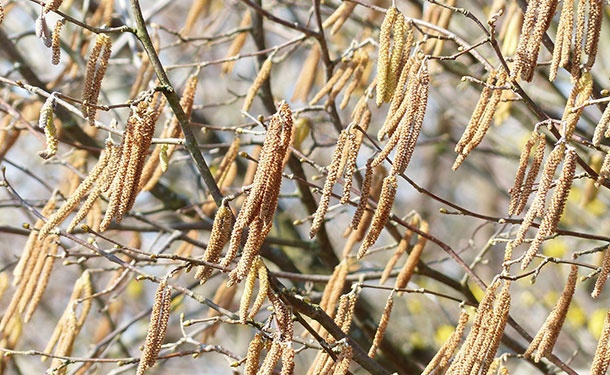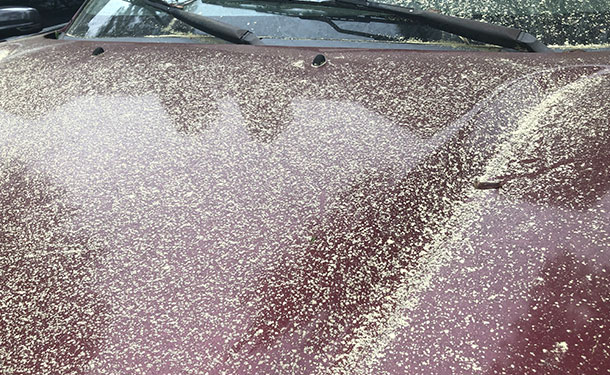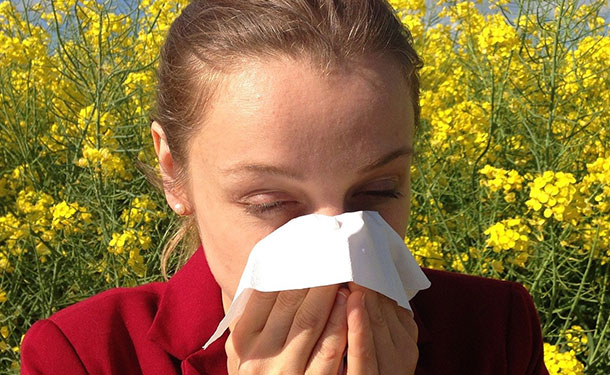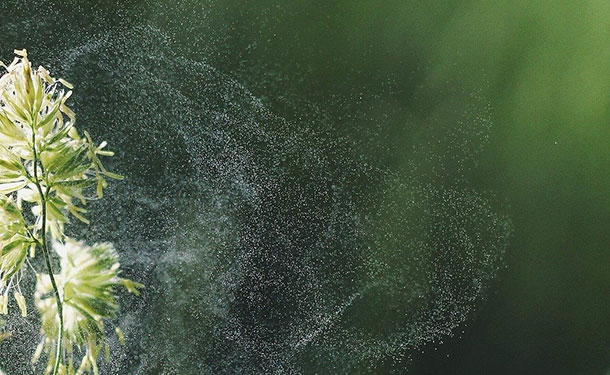Don’t let tree pollen allergies steal your joy this spring. Knowing how to cope with seasonal pollen allergies can help you breathe easy and give you a better perspective on seasonal changes.

thetreecareguide.com gathered information on pollen allergy seasons, symptoms, and allergy relief.
Tree Pollen Season
Springtime is a beautiful time. The flowers are beginning to bloom, the grass is turning vibrant shades of green, and trees are filling back in after their winter slumber. About those trees, they are also producing insane amounts of pollen.

Allergy season for those who suffer from allergic rhinitis (pollen allergies or hay fever) begins when trees initiate pollen production. The more significant culprits for tree pollen dispersion are:
• Alder
• Ash
• Aspen
• Beech
• Birch
• Box Elder
• Cedar (November to January)
• Cottonwood
• Elm
• Hickory
• Mountain Elder
• Mulberry
• Maple
• Oak
• Olive
• Pecan
• Poplar
• Sycamore
• Willow
Some tree allergies can cause sensitivity to certain foods. Some proteins in vegetables, fruits, and nuts are similar enough to tree pollen to confuse your immune system. When eating these foods, you may develop an itchy or swollen mouth, face, or throat. This reaction is known as oral allergy syndrome (OAS). It is frequently triggered in people allergic to Alder and birch trees.
Anaphylaxis is a life-threatening reaction often prompted by a cross-reaction between tree pollen and nuts like almonds and peanuts. If itching or swelling occurs while eating nuts, you should seek medical attention immediately.
Watch this video to see the volume of pollen a single tree can produce.
Tree Pollen Allergy Symptoms
Pollen released by trees (February – July), grasses (May – June), weeds (July – October), and cedar (December – January) can cause people with pollen allergies to have the following symptoms:
• Sneezing
• Runny Nose
• Mucus Production
• Itchy Nose, Eyes, Ears, and Mouth
• Nasal Congestion
• Red and Watery Eyes
• Swelling Around the Eyes
• Coughing
Those who suffer from allergic asthma and are allergic to tree pollen may exhibit asthma symptoms which include:
• Coughing
• Difficulty Breathing
• Shortness of Breath
• Wheezing
• Chest Tightness
If you are experiencing asthma symptoms, it is highly recommended to seek medical attention.

Tree Pollen Allergy Relief
There are many options available for relieving pollen allergy symptoms. You can talk to your doctor or a board-certified allergist about your symptoms and treatment options. Medicines that may be prescribed are:
• Cromolyn sodium nose spray
• Leukotriene receptors
• Nasal corticosteroids
• Antihistamines
• Decongestants
Some over-the-counter (OTC) medications include:
• Benadryl (diphenhydramine)
• Zyrtec (Cetirizine)
• Dimetapp and Nasahist B (Brompheniramine)
• Allegra (Fexofenadine)
• Xyzal (Levocetirizine)
• Claritin and Alavert (Loratadine)
• Chlor-Trimeton (chlorpheniramine)
• Tavist (Clemastine)
Before taking any medication, consult with your primary care physician to evaluate your symptoms and recommend an appropriate medication, exposure reduction, or dietary change. Other options may include a long-term treatment regimen like immunotherapy to reduce the severity of your allergic reactions.
Tree Pollen Exposure
During the tree pollen season, that “yellow dust” seems to infiltrate and cover just about everything in sight. However, the following steps can be taken to reduce your exposure to it.
Testing – If you have not been tested for allergies, see a board-certified allergist to get tested for pollen allergies. Once you know which allergy you have, the more precise your treatment can be.
Research – Learn more about the trees in your region and when they produce the most pollen. For example, pine tree pollen peaks in the morning. If pine tree pollen triggers your allergies, reserve outdoor activities for later in the day.
Medication – Start taking allergy medication before the start of the pollen season.
Environment – Keep your windows and doors closed. Use HEPA filters or ones rated for pollen capture on the air intake of your central air unit.
Wearing Your Clothes – Change and wash the clothes you use outdoors.
Drying Your Clothes – Use a dryer to dry your clothes instead of hanging them outside.
Shower – Take a shower after outdoor activities. Pollen can easily hitch a ride on your skin and in your hair.
Driving – During your commute, keep your windows rolled up and activate the recycle feature on the car’s air system.
Move – Another way to avoid a long pollen season is to move to a region where pollen seasons are shorter, and trees are more sparse.
Another method of avoidance is through education. The American Academy of Allergy Asthma & Immunology (AAAAI) offers an interactive tool through their National Allergy Bureau (NAB) to see realtime pollen counts by city or region and further defines conditions, treatments, and education. You can access this resource at www.aaaai.org/global/nab-pollen-counts?ipb=1

Allergy Season Relief
In this article, you discovered information about the tree pollen allergy season, allergy symptoms, allergy relief, and how to reduce your exposure to pollen.
By identifying your allergies and taking proactive measures to mitigate them, you are saving yourself from feeling miserable and unable to function normally.
When you ignore pollen season and neglect the steps to reduce your exposure, you may find yourself reliant on medications and the side-effects they bring with them.
Sources:
aafa.org/pollen-allergy/
ncbi.nlm.nih.gov/pmc/articles/PMC4829390/
medlineplus.gov/hayfever.html
aaaai.org/
climate.gov/news-features/climate-and/climate-allergies
zyrtec.com/allergy-guide/outdoor-allergies/pollen-allergy-type-by-season